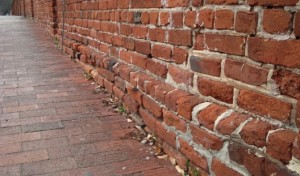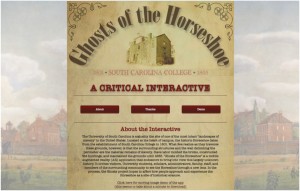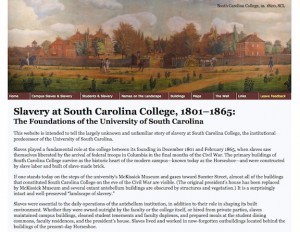Revealing slavery’s legacy at a public university in the south (Part 3)
27 October 2014 – Evan Kutzler, Sarah Conlon, Jamie Diane Wilson, and JoAnn Zeise
politics, race, graduate students, digital media, The Public Historian, preservation, slavery, projects, evaluation, advocacy, public engagement, digital history, publicity, education
In the final post of this series, we consider how the “Slavery at South Carolina College” project has been received. The most important effects have been local. The website has acted as a catalyst that has increased awareness of slavery at the university and an interest among students and faculty in speaking plainly about that history. The Richland County Public Library invited the team that created the site to present the research to community members in February 2012, and individual students have guest-lectured on the topic in university classes. Responses from students and members of the community seem to reflect a desire among at least some in the public to learn about and discuss tough issues in our shared history. One South Carolina undergraduate wrote in the feedback section of the website, “I viewed this website as a class assignment, but I am so grateful to my professor for doing so…. This is a great website and should be made part of the introductory information students receive about the University of South Carolina.” The university’s first-year experience course now encourages its instructors to incorporate the website into the curriculum. An anonymous commentator posted this recent feedback: “There are many dorms and buildings honoring White men who have owned slaves but no building or piece of land to honor the hard work that blacks have done….All I can say is ‘Why?’” One useful lesson for public historians is that our digital visitors did not seem to shy away from the controversial topic. This website suggests that confronting complicated history can encourage students and members of the public to rethink traditional narratives.

This brick wall, built by enslaved laborers in the early nineteenth century, still surrounds the antebellum center of the campus. Photo credit: Slavery at South Carolina College team
An important preservation offshoot came in the form of newfound attention to a slave-built wall that surrounds the historic campus. A historic structure report on the wall, conducted by other students in the same seminar that produced the website, indicated its neglected state: bricks damaged by the use of Portland cement; invasive plant roots; and nail-holes from generations of students who have used it to post banners and signs. The team’s findings precipitated a conversation that led to the allocation of $1.5 million from the university over the following four years to the appropriate preservation of the structure. That the Wall Report, a single component of a large website, could inspire such an investment from the university is testament to the ways this project took on a life in ways we could not have imagined.
The website also served as an intellectual catalyst for further research and development. The most rewarding praise came when others at the university began taking an interest in the project, carrying it in new directions with fresh energy and enthusiasm. Colleagues in the digital humanities have expanded on this project by using new, interactive media to capture the power of place and foster experiential authenticity and learning. A mobile application, “Ghosts of the Horseshoe,” blends the scholarship of “Slavery at South Carolina College” with new media approaches such as augmented reality (AR) and critical interactives (CI). [1]

A subsequent mobile application blends the scholarship of “Slavery at South Carolina College” with new media approaches, such as augmented reality (AR) and critical interactives (CI).
These related media strategies enable users to access additional information by pointing a mobile device at an object or landscape feature. CI employs a humanities-oriented, interactive design that offers participants a more active role in the learning process than do traditional websites. The anticipated prototype contains three layers, focusing on the wall; extant and former structures; and people, including slaves, students, and faculty. The application aims to challenge how people in the present understand the campus as well as to counter what Heidi Rae Cooley and Duncan A. Buell call “historical erasure” and “social blindness” in institutional histories by using technology to foster social experience and personal introspection. [2]
As the initiative in digital humanities suggests, there are other directions similar projects could take in the future. Interactivity is an important and increasingly necessary part of digital history. Digital history projects like the website could also benefit from better ways to assess visitor experience. In practice, we discovered that visitor feedback had to be encouraged. When we publicized the website on several H-Net listservs in February 2012, we received only a dozen or so comments. The greatest volume of feedback, most of it encouraging, came from people from whom we solicited input or from students whose instructors required the class to visit the website.
There could also be greater official acknowledgment of slavery from the university administration. While colleagues in the Public History Program, Digital Humanities, Library and Information Science, University Archives, Anthropology, Southern Studies, and Facilities Management have shown interest in the project, the response from the university administration has been minimal. The only building on campus without a name is a two-story kitchen in the president’s garden. For decades in the nineteenth century, this two-story kitchen doubled as a slave quarters, but there no is indication of that today. The financial commitment to preserving the wall is important, but the university could also address the history embedded within that wall and all the buildings of the antebellum college. This includes recognition of the enslaved people whose labor was so important to the college in its first sixty years.
Above all, the website succeeded in breaking the silence about an important topic in the history of the University of South Carolina. The students and the instructor catalyzed a cross-discipline alliance that has led to a long-term interest across the university community. As in the case of “Slavery at South Carolina College,” the subsequent “Ghosts of the Horseshoe” initiative suggests that a project that builds alliances is more sustainable than one that does not. This is perhaps the most important lesson for public historians: propagate interest by catalyzing others to pick up the next phase of the project and go in new directions. This alleviates the challenge created by graduate students’ moving on to other projects and careers, creates the opportunity for greater critical reflection and feedback, and encourages regeneration and refinement of a public history project that tells a complicated story.
~ Evan Kutzler is a PhD candidate in history and an alumnus of the Public History Program at the University of South Carolina. He writes on nineteenth-century America, public history, and, especially, the history of the senses.
~ JoAnn Zeise is an alumna of the Public History Program at the University of South Carolina. She received her MA in the summer of 2012. She is currently the Curator of History at the South Carolina State Museum. Her research interests include the cultural history and material culture of South Carolina.
~ Sarah Conlon is an alumna of the Public History program at the University of South Carolina. Her research interests are gender and healthcare in the US South. She received her MA in the summer 2012. She is currently the Collections Manager at the Battleship TEXAS State Historic Site in La Porte, Texas.
~ Jamie Diane Wilson is a PhD candidate in US History and Instructor in US History to 1865 at the University of South Carolina. Her research interests include Antebellum Southern intellectual history and public history.
[1] The term “critical interactives” was coined by Heidi Rae Cooley and Duncan A. Buell in “Critical Interactives: Improving Public Understanding of Institutional Policy,” Bulletin of Science, Technology, and Society 32 (December 2012), 486-493.
[2] Cooley and Buell, “Critical Interactives,” 491.
Acknowledgements: The co-authors of this series want to express their gratitude to Robert Weyeneth, who conceptualized the idea of using an undergraduate senior seminar and a graduate class to research the subject of slavery at the University of South Carolina over the 2010-2011 academic year, as well as to the other team members who made the project possible: Allison Baker, Jennifer Betsworth, Rebecca Bush, Justin McIntyre, and Elizabeth Oswald. For others who supported the website, please see the Acknowledgements page on the website. We would also like to thank Graham Duncan, an archivist at the South Caroliniana Library whose 2006 senior thesis, “Peculiarly Suited for the Services of the Institution: Slavery at South Carolina College,” pioneered the study of slavery at South Carolina College.
The project benefited at all stages from strong interdepartmental cooperation from the University of South Carolina Digital Collections and the South Caroliniana Library. Their support and contribution of resources proved to be indispensable. Digital Collections, especially Kate Boyd, volunteered staff time to scan and store documents online as well as transfer the website to its permanent home on the university server. The project would have been impossible without the active and enthusiastic support of the university archivist, Elizabeth West, and her staff and colleagues.





1 comment